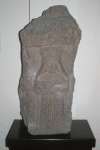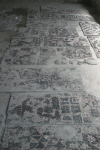
Ruins of Gordion. (887k)
Gordion was occupied by the Phrygians as early as the 9th century BCE. It soon became the capital of Phrygia.
It was conquered by the Cimmerians, then the Lydians, the Persians, and finally by Alexander the Great. The Galatian occupation of 278 BCE put an end to the city.
One of the most famous Phrygians was King Midas (of the golden touch) from the late 8th century BCE.
The landscape of this area is dotted with tumuli (burial mounds) that cover the graves of Phrygian Kings. In 1957, the intact tomb of a Phrygian King was discovered in one of the tumuli. This king was probably buried between 740 BCE and 718 BCE. The tomb is actually a gabled cottage of cedar, surrounded by juniper logs. It is the oldest wooden structure discovered in Anatolia, and perhaps the world. The tumulus itself is 60 m (200 ft) high and 300 m (980 ft) in diameter. It is not clear which king was buried here, it may have been the father or grandfather of King Midas.
All pictures are © Dr. Günther Eichhorn, unless otherwise noted.





This page contains 5 pictures

Main page for Türkiye Cumhurieti (Turkey)
Page last updated on Thu Mar 21 09:49:24 2019 (Mountain Standard Time)
Page last updated on Wed Apr 24 01:39:41 2024 (Mountain Standard Time)
Gordion on soaring.guenther-eichhorn.com